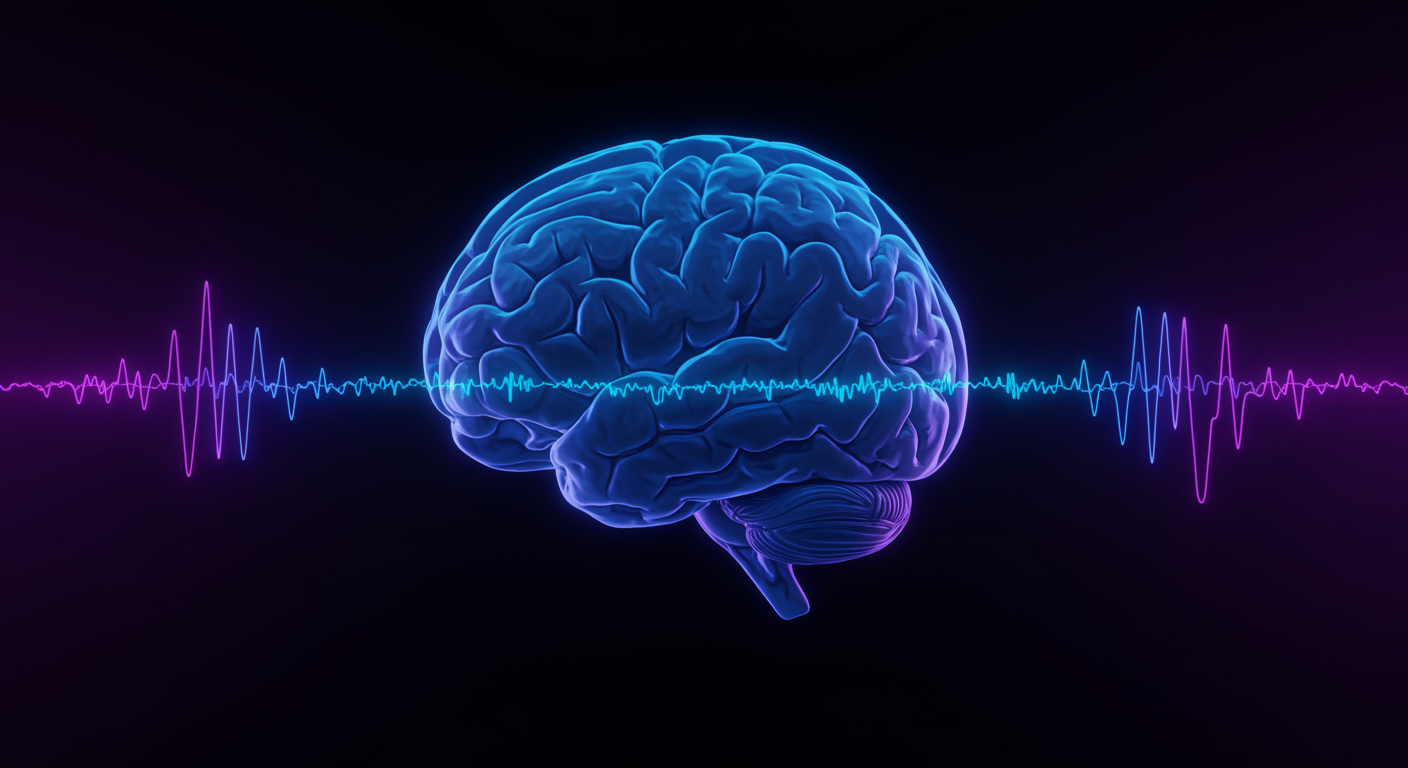Do Brain Waves, Blood Flow, and Spinal Fluid Move in Sync During Sleep?
Yes, and this coordination is essential for sleep’s restorative functions. This landmark study revealed that during human sleep, brain electrical activity, blood flow, and cerebrospinal fluid movement oscillate together in a precisely coordinated symphony. These coupled oscillations create optimal conditions for waste clearance, memory consolidation, and brain restoration—showing that sleep isn’t just the absence of wakefulness, but an active, orchestrated process that maintains brain health.
Dr. Kumar’s Take
This research fundamentally changes how we understand what happens in the brain during sleep. We’re not just looking at brain waves anymore—we’re seeing a coordinated dance between electrical activity, blood circulation, and fluid movement that’s essential for brain maintenance. The fact that these systems oscillate together suggests that disrupting any one component could impair the entire restorative process. This explains why sleep quality matters as much as sleep duration, and why conditions that fragment sleep or disrupt brain blood flow can have such profound effects on cognitive health. It’s like discovering that sleep is a carefully choreographed performance where every system must work in harmony.
Key Findings
Using advanced neuroimaging techniques, researchers simultaneously measured brain electrical activity (EEG), blood flow (fMRI), and cerebrospinal fluid movement in sleeping humans. They discovered that these three systems oscillate together in slow, synchronized waves during non-REM sleep. The sequence follows a specific pattern: neural activity decreases, blood flow reduces, and cerebrospinal fluid flows into the brain to clear waste products.
These coupled oscillations occur at frequencies of 0.05-0.1 Hz (one cycle every 10-20 seconds) and are most prominent during deep sleep stages. The coordination is so precise that researchers could predict cerebrospinal fluid flow patterns based on brain wave activity. This synchronization appears to optimize conditions for the brain’s waste clearance system, allowing maximum fluid exchange when neural activity is lowest.
The study also revealed that these oscillations become less coordinated with aging and may be disrupted in various neurological conditions, potentially explaining why sleep quality often declines with age and disease.
Brief Summary
This study used simultaneous EEG-fMRI recording combined with specialized MRI sequences to measure cerebrospinal fluid flow in healthy adults during natural sleep. Thirteen participants underwent overnight sleep studies in an MRI scanner while researchers recorded brain electrical activity, blood oxygen levels, and cerebrospinal fluid movement. The study focused on non-REM sleep stages when these oscillations are most prominent. Advanced signal processing techniques identified the coupling between different physiological systems and characterized their temporal relationships during sleep.
Study Design
This was an observational study using simultaneous multimodal neuroimaging during natural human sleep. Participants underwent polysomnography (sleep monitoring) combined with functional MRI and specialized fluid-sensitive MRI sequences. EEG electrodes recorded brain electrical activity while MRI measured blood flow and cerebrospinal fluid movement in real-time. The study required participants to sleep naturally in the MRI scanner, which was technically challenging but provided unprecedented insights into sleep physiology. Statistical analysis examined the temporal relationships between different oscillatory signals and their coordination across sleep stages.
Results You Can Use
The study revealed that brain electrical activity, blood flow, and cerebrospinal fluid movement are tightly coupled during non-REM sleep, oscillating together every 10-20 seconds. This coordination is strongest during deep sleep stages and weakest during REM sleep and wakefulness. The pattern follows a specific sequence: neural activity decreases first, followed by reduced blood flow, then increased cerebrospinal fluid influx that helps clear metabolic waste.
These oscillations are most robust in young, healthy adults and become less coordinated with aging. The coupling strength correlates with sleep quality measures, suggesting that better-coordinated oscillations may indicate more restorative sleep. Disruption of this coordination may impair the brain’s ability to clear waste products and consolidate memories, potentially contributing to cognitive decline and neurodegenerative disease risk.
Why This Matters For Health And Performance
The coordination between brain waves, blood flow, and cerebrospinal fluid creates optimal conditions for the brain’s nightly maintenance tasks. During the low neural activity phase, reduced blood flow decreases the delivery of metabolic substrates, while increased cerebrospinal fluid flow enhances waste removal. This coordination ensures that waste clearance occurs when it’s most needed and least disruptive to neural function. Disruption of these oscillations may impair memory consolidation, reduce waste clearance efficiency, and compromise sleep’s restorative benefits. Understanding this coordination helps explain why sleep fragmentation is so detrimental—it’s not just about total sleep time, but about maintaining the delicate orchestration of these physiological processes.
How to Apply These Findings in Daily Life
- Prioritize deep sleep: The coupled oscillations are strongest during deep non-REM sleep stages
- Maintain consistent sleep schedules: Regular sleep timing supports the coordination of these oscillatory systems
- Avoid sleep fragmentation: Frequent awakenings can disrupt the coordination between brain waves, blood flow, and fluid movement
- Address sleep disorders: Conditions like sleep apnea may disrupt these coordinated oscillations
- Consider sleep position: Some research suggests certain positions may optimize cerebrospinal fluid flow
- Limit alcohol and sedatives: These substances can alter sleep architecture and potentially disrupt oscillatory coordination
Limitations To Keep In Mind
This study involved a small number of healthy young adults, and the findings may not apply to all age groups or populations with sleep disorders. Sleeping in an MRI scanner is not natural and may have affected sleep quality or architecture. The study focused primarily on non-REM sleep, so the role of these oscillations during REM sleep remains less clear. Additionally, the long-term consequences of disrupted oscillatory coupling and methods to enhance this coordination require further research.
Related Studies And Internal Links
- Sleep Drives Brain Waste Clearance: Your Nightly Detox System
- Brain’s Hidden Highway: CSF Flow Through Neural Tissue
- Association of Sleep Duration with Incidence of Dementia in Middle and Old Age
- Glycine Ingestion Improves Subjective Sleep Quality in Human Volunteers
- How to Sleep Better: Science Daily Playbook
FAQs
What happens if these oscillations become uncoordinated?
Disrupted coordination between brain waves, blood flow, and cerebrospinal fluid may impair waste clearance and memory consolidation, potentially contributing to cognitive decline and increased risk of neurodegenerative diseases.
Can these oscillations be enhanced or improved?
While research is ongoing, maintaining good sleep hygiene, achieving adequate deep sleep, and addressing sleep disorders may help optimize the coordination of these oscillatory systems. Regular sleep schedules and avoiding sleep fragmentation appear important.
Do these oscillations occur during all sleep stages?
The coupled oscillations are most prominent during non-REM sleep, particularly deep sleep stages. They are much weaker or absent during REM sleep and wakefulness, suggesting they serve specific restorative functions.
Conclusion
Sleep involves precisely coordinated oscillations between brain electrical activity, blood flow, and cerebrospinal fluid movement that create optimal conditions for brain maintenance. This discovery reveals sleep as an active, orchestrated process where multiple systems work in harmony to restore and maintain brain health through waste clearance and memory consolidation.


